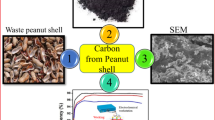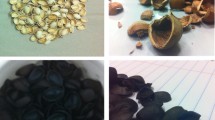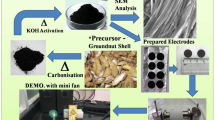Abstract
Recently, the supercapacitor has gained more consideration due to its speedy charging and discharging, high power density, and stability compared to the existing batteries. Activated carbon-based electrodes for the supercapacitor provide higher specific capacitance. In this research, activated carbon was obtained from Prunus dulcis (almond fruit) shell by carbonization using a muffle furnace. Carbonized Prunus dulcis fruit shells were chemically activated by potassium hydroxide (KOH). X-ray diffraction (XRD) patterns of KOH-activated carbon derived from Prunus dulcis shell evident that the activated carbon samples are amorphous. The scanning electron microscope (SEM) images of activated carbon derived from Prunus dulcis exhibited a 2D sheet-like morphology and a smooth surface. Energy-dispersive X-ray spectroscopy (EDX) detected oxygen, chloride, and potassium peaks with 85.2% carbon. The addition of KOH helped to increase the porosity of the fruit shells and enhanced the absorption of the electrolyte. The supercapacitor electrode was prepared by coating activated carbon on a graphite pencil lead. The performance of the electrode was evaluated using a 6 M KOH electrolyte at various current densities and scan rates. The prepared sample was electrochemically characterized by cyclic voltammetry, galvanostatic charge and discharge measurements, and electrochemical impedance spectroscopy. From the analysis, the suitability of the material as an electrode can be understood. The specific capacitance of the samples was measured as 434, 237, 105.9, and 50.5 F g−1 at 1, 2, 4, and 10 A g−1, respectively. The higher specific capacitance is ascribed to the high specific surface area, electrolyte, and pore volume. And also, at an energy density of 0.28 Wh g−1, the power density of 100 kW g−1 is obtained. The electrode has a series resistance of 10.51 Ω and a charge transfer resistance of 1.12 Ω.











Similar content being viewed by others
References
Kandasamy SK, Kandasamy K (2019) Graphene–polyanilinenanocomposite treated with microwave as a new supercapacitor electrode and its structural, electrochemical properties. J New Mater Electrochem Syst 22(3):125–131
Kandasamy SK, Singaram KN, Krishnamoorthy H, Arumugam C, Palanisamy S, Kandasamy K, Khan A, Asiri AM and D-Cancar H. 2021. Microwave‐assisted graphene‐based conducting polymer materials for supercapacitors. Handbook of Supercapacitor Materials: Synthesis, Characterization, and Applications. 299–326.
Sivalingam D, Elangovan H, Subramanian M, Kandasamy SK, Govindasamy M (2013) Synthesis and characterization of PANI/ferric chloride composite for fabrication of electrodes in supercapacitor. Adv Mater Res 768:334–337
Kandasamy SK, Kandasamy K (2018) Recent advances in electrochemical performances of graphene composite (graphene-polyaniline/polypyrrole/activated carbon/carbon nanotube) electrode materials for supercapacitor: a review. J Inorg Organomet Polym Mater 28(3):559–584
Kandasamy SK, Arumugam C, Sajitha AS, Rao SP, Selvaraj S, Vetrivel R, Selvarajan R, Alosaimi AM, Khan A, Hussein MA, Asiri AM (2021) Paradisiaca/Solanum tuberosum biowaste composited with graphene oxide for flexible supercapacitor. J New Mater Electrochem Syst 24(1):21–28
Kandasamy SK, Arumugam C, Vadivel L, Ganapathi M, Nattudurai NK (2020) Synthesis of chemically modified activated carbon for supercapacitor electrode derived from fibers of musa paradisiacal. Int J Emerg Technol 11(3):565–569
Devendran M, Kandasamy SK, Palanisamy S, Selvaraj S, Vetrivel R, Selvarajan R, Govindasamy M, Kandasamy K (2020) Preparation of chemically modified porous carbon networks derived from Citrus Sinensis flavedos as electrode material for supercapacitor. Int J Electrochem Sci 15(4):4379–4387
Liu Y, Chen J, Cui B, Yin P, Zhang C (2018) Design and preparation of biomass-derived carbon materials for supercapacitors: a review. J Carbon Res 4(4):53
Ahmed S, Ahmed A, Rafat M (2018) Supercapacitor performance of activated carbon derived from rotten carrot in aqueous, organic and ionic liquid based electrolytes. J Saudi Chem Soc 22(8):993–1002
Nor NS, Deraman M, Suleman M, Jasni MR, Manjunatha JG, Othman MA, Shamsudin SA (2017) Supercapacitors using binderless activated carbon monoliths electrodes consisting of a graphite additive and pre-carbonized biomass fibers. Int J Electrochem Sci 12:2520–2539
Xu C, Xu F, Sun L, Cao L, Yu F, Zhang H, Yan E, Peng H, Chu H, Zou Y (2019) A high-performance supercapacitor based on nitrogen-doped porous carbon derived from cycas leaves. Int J Electrochem Sci 14(1):1782–1793
Taer E, Apriwandi A, Ningsih YS, Taslim R, Agustino A (2019) Preparation of activated carbon electrode from pineapple crown waste for supercapacitor application. Int J Electrochem Sci 14:2462–2475
Maryati D, Harsojo K, Bambang P (2017) The effect of concentration nanoparticles MnO2 doped in activated carbon as supercapacitor electrodes. Int J Appl Eng Res 12:0973–4562
Jiang Q, Liu D, Liu B, Zhou T, Zhou J (2019) Blotting paper-derived activated porous carbon/reduced graphene oxide composite electrodes for supercapacitor applications. Molecules 24(24):4625
Andres B, Forsberg S, Vilches AP, Zhang R, Hummelgård M, Bäckström J, Olin H, Andersson H (2012) Supercapacitors with graphene coated paper electrodes. Nord Pulp Pap Res J 27(2):481–485
Wang X, Kong D, Zhang Y, Wang B, Li X, Qiu T, Song Q, Ning J, Song Y, Zhi L (2016) All-biomaterial supercapacitor derived from bacterial cellulose. Nanoscale 8(17):9146–9150
Kaushal I, Maken S, Kumar SA (2018) SnO2 mixed banana peel derived biochar composite for supercapacitor application. Korean Chem Eng Res 56(5):694–704
Nirmaladevi S, Boopathiraja R, Kandasamy SK, Sathishkumar S, Parthibavarman M (2021) Wood based biochar supported MnO2 nanorods for high energy asymmetric supercapacitor applications. Surf Interfaces 27:101548
Palisoc S, Dungo JM, Natividad M (2020) Low-cost supercapacitor based on multi-walled carbon nanotubes and activated carbon derived from Moringa Oleifera fruit shells. Heliyon 6(1):e03202
Wei H, Wang H, Li A, Li H, Cui D, Dong M, Lin J, Fan J, Zhang J, Hou H, Shi Y (2020) Advanced porous hierarchical activated carbon derived from agricultural wastes toward high-performance supercapacitors. J Alloy Compd 820:153111
Vinayagam M, Babu RS, Sivasamy A, de Barros AL (2020) Biomass-derived porous activated carbon from Syzygiumcumini fruit shells and Chrysopogon zizanioides roots for high-energy-density symmetric supercapacitors. Biomass Bioenerg 143:105838
Palanisamy S, Kandasamy SK, Thangmuthu S, Selvarasu DK, Panchanathan M, Ramanai PV, Gevert BS (2021) Synthesis of activated carbon from black liquor for the application of supercapacitor. J Mater Sci: Mater Electron 32(20):25175–25187
Dai P, Zhang S, Liu H, Yan L, Gu X, Li L, Liu D, Zhao X (2020) Cotton fabrics-derived flexible nitrogen-doped activated carbon cloth for high-performance supercapacitors in organic electrolyte. ElectrochimicaActa 354:136717
Manickavasakam K, Balaji SS, Kaipannan S, Raj AK, Veeman S, Marappan S (2020) Electrochemical performance of Thespesia populnea Seeds derived activated carbon-supercapacitor and its improved specific energy in redox additive electrolytes. J Energy Storage 1(32):101939
Kandasamy SK, Subramanian B, Krishnamoorthy H, Arumugam C, Suganthi V, Yuvasri M, Shreelogesh D (2021) Chemically treated activated carbon for supercapacitor electrode derived from the starch of Solanum tuberosum. J New Mater Electrochem Syst 24(2):78–83
Jain D, Kanungo J, Tripathi SK (2020) Enhancement in performance of supercapacitor using eucalyptus leaves derived activated carbon electrode with CH3COONa and HQ electrolytes: a step towards environment benign supercapacitor. J Alloy Compd 15(832):154956
Anand GT, Renuka D, Ramesh R, Anandaraj L, Sundaram SJ, Ramalingam G, Magdalane CM, Bashir AK, Maaza M, Kaviyarasu K (2019) Green synthesis of ZnO nanoparticle using Prunusdulcis (Almond Gum) for antimicrobial and supercapacitor applications. Surf Interfaces 1(17):100376
Li Y, Zhang X, Deng J, Yang X, Wang J, Wang Y (2020) Hierarchical porous biochar derived from Cotinus coggygria flower by using a novel composite activator for supercapacitors. Chem Phys Lett 747:137325
Kumar R, Soam A, Sahajwalla V (2020) Sucrose-derived carbon-coated nickel oxide (SDCC-NiO) as an electrode material for supercapacitor applications. Mater Adv 1(4):609–616
Eleri OE, Azuatalam KU, Minde MW, Trindade AM, Muthuswamy N, Lou F, Yu Z (2020) Towards high-energy-density supercapacitors via less-defects activated carbon from sawdust. ElectrochimicaActa 362:137152
Gunasekaran SS, and Badhulika S (2022) Almond peel‐derived iron‐induced activated carbon for high energy and long‐life supercapacitor in organic electrolyte. Energy Storage. e404. https://doi.org/10.1002/est2.404
Xu H, Gao B, Cao H, Chen X, Yu L, Wu K, Sun L, Peng X, Fu J (2014) Nanoporous activated carbon derived from rice husk for high-performance supercapacitor. J Nanomater 1:2014
Kalyani P, Anitha A (2013) Refuse derived energy-tea derived boric acid activated carbon as an electrode material for electrochemical capacitors. Port Electrochim Acta 31(3):165–174
Kumar KS, Chandrasekaran A, Kannan K, Murugesan G (2018) Effects of microwave annealing of graphene and its impact on structural, electrochemical performance for energy storage. In 2018 International Conference on Intelligent Computing and Communication for Smart World (I2C2SW) 2018. 241–243.
Arumugam C, Kandasamy SK, Gunasekaran K, Somasundaram K, Eswaramoorthi KP (2021) Hierarchical structure of graphene oxide/polyaniline composite flexible supercapacitor. AIP Conf Proc 2387(1):090003
Kandasamy SK, Arumugam C, Vadivel L, Kandasamy S, Karuppaiah D (2021) Fabrication of ZnO–Carbonized cotton yarn derived hierarchical porous active carbon flexible electrodes. AIP Conf Proc 2387(1):090005
Arumugam C, Kandasamy SK, Ravichandran S, Marimuthu S, Thangavel RP (2021) Hierarchical structure of graphene oxide/MnO2 electrodes for supercapacitor. AIP Conf Proc 2387(1):090004
Author information
Authors and Affiliations
Corresponding author
Additional information
Publisher's Note
Springer Nature remains neutral with regard to jurisdictional claims in published maps and institutional affiliations.
Rights and permissions
Springer Nature or its licensor (e.g. a society or other partner) holds exclusive rights to this article under a publishing agreement with the author(s) or other rightsholder(s); author self-archiving of the accepted manuscript version of this article is solely governed by the terms of such publishing agreement and applicable law.
About this article
Cite this article
Kandasamy, S.K., Ravindaran, R., Michalska, M. et al. Highly carbonized Prunus dulcis shell-derived activated carbon for high-performance supercapacitor applications. Polym. Bull. 80, 10881–10894 (2023). https://doi.org/10.1007/s00289-022-04562-y
Received:
Revised:
Accepted:
Published:
Issue Date:
DOI: https://doi.org/10.1007/s00289-022-04562-y




